If you’ve been following along with this simple pasta series, you knew that this one was coming. In fact, given the response to these posts, I’d say this is the most anticipated one of all. It’s certainly one of the best known Italian pastas outside of Italy, and easily the best known of the classic Roman pastas. In some ways, it’s the hardest to get right. But, only if you haven’t started with the principles that I laid out in the previous posts Because the same process applies, and prevents the most common problem with preparing this pasta – the egg scrambling and/or the cheese getting stringy.
We’re talking Spaghetti alla carbonara here. A subject that I devoted a bit of time and exploration to: here, here, and here. In fact, I did a little demo of the process of making the dish at the end of the third link – slightly different from the step by step approach I’m offering up today.
If you start from alla gricia, the only difference between the two is the egg. Instead of subtracting an ingredient, guanciale, as we did in making cacio e pepe, we’re adding one in. The name, carbonara, a “coal burner”, refers to the miners from whom the recipe supposedly originated. Other origin stories claim that it’s the speckling of pepper, like carbon, but that would more sensibly apply to cacio e pepe, which typically has far more pepper. Another is that it’s named for the secret society of “charcoalmen”, the carbonari, though no one seems to have a reason that that makes sense. There are even stories that the recipe was invented by American GIs in Italy during WWII, who took the classic Abruzzese pasta cacio e ovo, cheese and egg, and added their breakfast bacon to it. One of the most credible is a combination – that Italian chef Renato Gualandi made the dish for some American top brass at a dinner in 1944, using ingredients sourced from the American military – bacon, powdered egg yolks, and, dare one say it, cream. It is true that the first in print use of the name carbonara for this pasta wasn’t until 1952, though most Italian food historians simply claim that it’s a peasant dish that no one bothered to write up in a book or newspaper before then. It’s likely, we’ll never know for sure.
There were, it should be noted, many variations over the years. From the time that first recipe was published in the early 50s, various Italian chefs experimented with the recipe. In fact, that first written recipe (by an American food writer, it should be noted) used pancetta, or cured pork belly, as opposed to the smoked that we’re used to as bacon, parmigiano, and whole eggs, and actually scrambled the eggs into the pasta. In the late 50s and early 60s versions using peas, mushrooms, onions, garlic, alone or in combination, and with different cheeses. In fact, the first recipe published in the Italian press used lots of mezzina, a Tuscan smoked bacon, garlic, parsley, and, Gruyere cheese from Switzerland! But by the mid to late 60s, Italians, or at least Italian food writers, had settled on the core ingredients of guanciale, pecorino, and eggs – usually mostly yolks with just a little of the whites. Though I’m not a fan of their dialogue style, the folks at Pasta Grammar have made an interesting video comparing versions.
Let’s start, as always, with our ingredients. Spaghetti is the most traditional for this dish, though some swear by other pastas. Rigatoni is a common one, as we used for making the gricia. And once again, we have pecorino romano, the local sheep’s milk cheese; guanciale, herb-cured pork jowl (again, herb-cured pork belly, or pancetta is a decent substitute if you can’t find the former); black pepper; and, our addition, eggs.
“Where’s the cream?” you scream. There is no cream in Italian carbonara. There is in many of the versions outside of Italy, and the earliest writeups of this dish in the US include cream. If the military theory has any reality, it’s probably here that someone trying to recreate that texture simply thought it had cream in it – exactly what we saw with the story of alfredo. There’s also no garlic, nor onion, both of which are common additions (and note, we didn’t use them in either of the previous Roman pastas, and won’t for amatriciana either) outside of Italy, but not part of the “classic” recipe. So what about the cream? You’ve seen from the previous posts that it’s not necessary in order to get a creamy texture. And if you stop to look at those ingredients… we have all the fat from the pork, the cheese, and eggs… do we really need to add in a fourth fat? I’ve tried making this exact recipe, just adding in a few tablespoons of cream, and you know what? It does nothing for the dish. If anything it mutes the flavors of the pecorino and guanciale, and why would you want to do that?
Get our guanciale diced up and slowly rendering in a pan. It takes about 7-8 minutes, so figure on a couple of minutes into this, drop your spaghetti into the boiling salted water (again, minimal water, just enough to cover, for this amount, two portions, I use a liter of water and a tablespoon of coarse salt).
Grate your cheese, and once the pasta water is nice and starchy, add a couple of tablespoons of it to the cheese, melting it down into a paste. Then add one whole egg and one yolk (probably should have used a second extra yolk for two portions, just to get a yellower, richer finished sauce). Whisk that all together.
Once the guanciale is nice and browned, and the fat rendered well, add a ladle of the pasta water to the skillet and stir vigorously to emulsify it together. Add some cracked pepper, I used about what probably amounted to a teaspoon total, so about half the amount I’d use in cacio e pepe, but that’s personal tastes.
When the spaghetti is about two minutes from its official done time (check the package!), scoop it out and add it to the skillet. You’ll probably add another ladle of pasta water at this point too, you need enough to finish cooking the pasta in it for two minutes. Most of it will absorb, leaving you with that lovely creamy emulsion at the bottom of the pan.
Once again, here’s the key to stop it from getting scrambled or stringy. Remove the pan from the heat. Completely. I move it onto a hot mitt on my countertop. Then add the cheese and egg mixture.
Stir and toss vigorously once again, and you’ll end up with perfectly creamy carbonara that clings to the pasta (another thing that the cream based version tends not to do as well, it has a tendency to not stick to the pasta well). Taste, add more pepper if you need to.
And serve.
By the way, if you don’t think that that sauce is creamy… just look at what remains behind. Then mop it up with some bread!
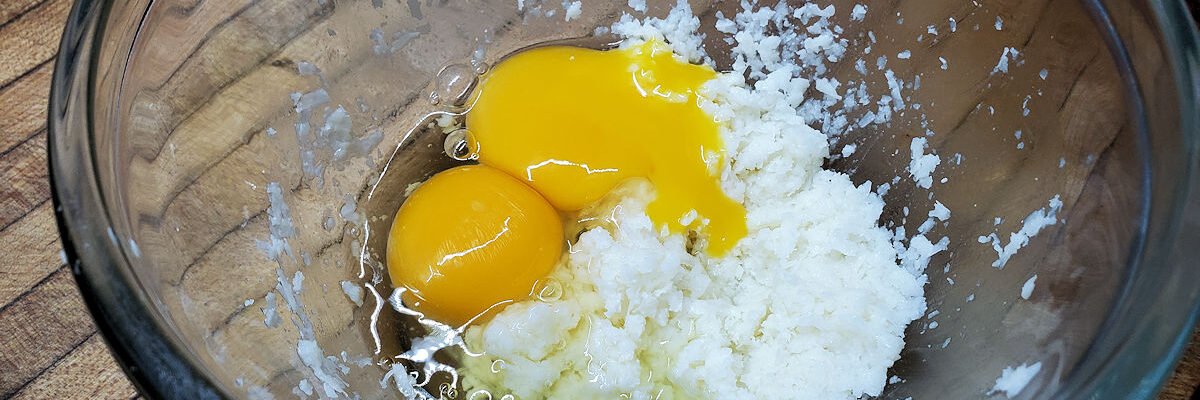
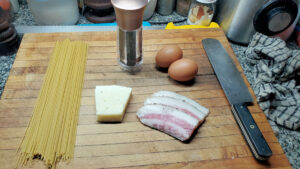
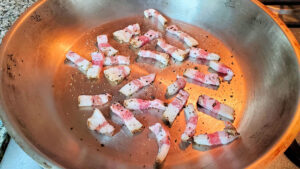
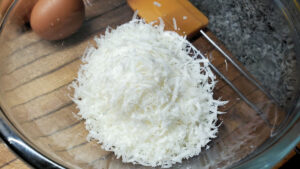
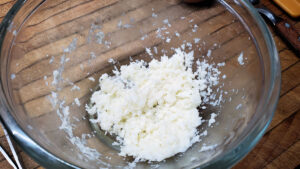
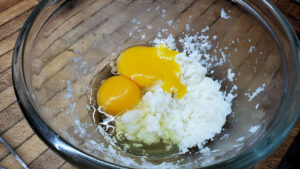
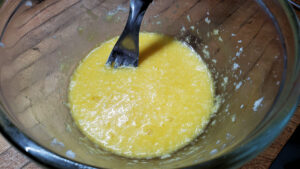
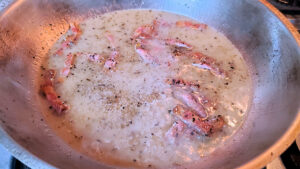
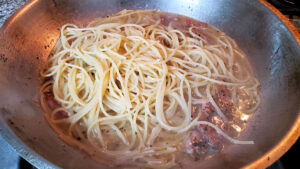
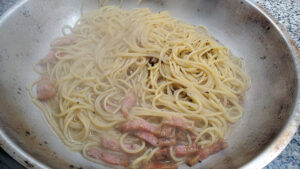
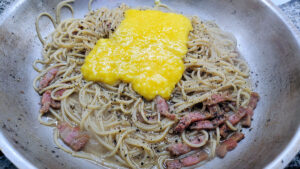
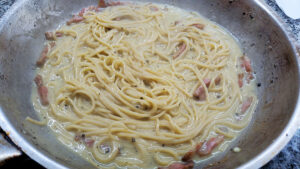
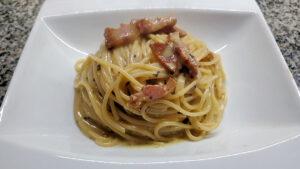
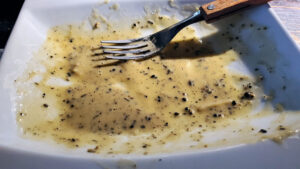
Bravo, Dan. Complimenti!
Grazie! Da parte tua, è un grande complimento!
[…] Risotto – Inspired by my explorations of pasta carbonara, but also by that really cool approach to risotto that we saw in one of my Tucci recreations. […]
[…] some people tout this as simply a mashup of carbonara and amatriciana. And this is near to the mark, but an incomplete description, as zozzona also […]
[…] of Rome, and their family tree connections. A quick reference back – gricia, cacio e pepe, carbonara, […]